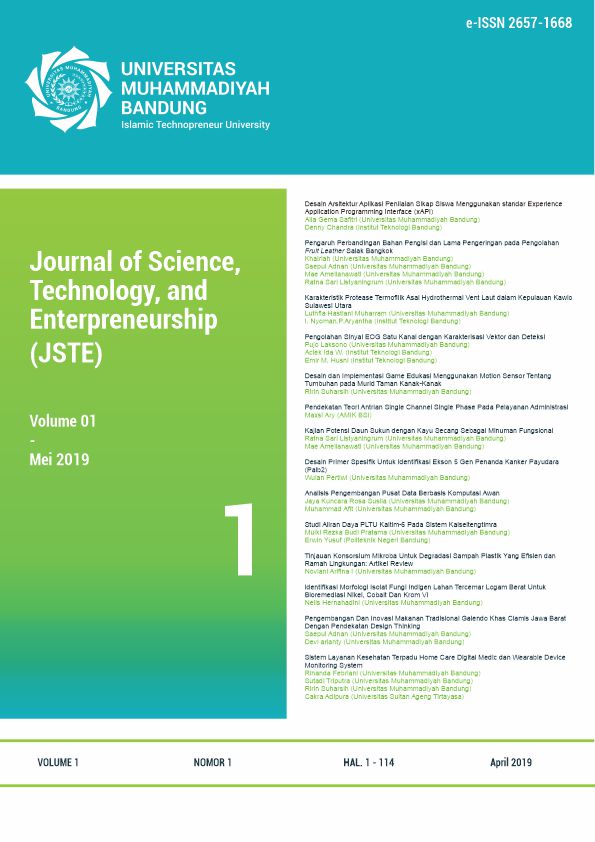Desain Dan Implementasi Game Edukasi Menggunakan Motion Sensor Tentang Tumbuhan Pada Murid Taman Kanak-Kanak
Kata Kunci:
Educational Game, Kindergarten, Motion SensorAbstrak
Activities that stimulate child growth and development include physical, spiritual, motoric, mind, emotional, and social development need to be fostered in kindergarten. Through games, children can learn many things. By playing children feel happy and able to concentrate longer so that their ability to remember becomes better. In previous research, it was known that the ability of children to adapt to technology is higher and more natural than textbooks. This shows that using information technology in early education can make the learning experience more effective and more enjoyable. The media used are in the form of educational games. However, in contrast to adults, children especially preschoolers do not have good communication skills. Therefore, it is necessary to develop educational games that are appropriate for children. Educational games that are developed must be safe and fun. In this study an educational game was developed with the content of how to care for plants, color recognition, and fruit recognition. Equipped with motion sensor technology, this educational game is expected to make it easier for children to play it, help train rough motorics, and make children not easily bored in playing. Design and implementation through stages: conducting literature studies, needs analysis, game design, making questionnaires, implementing and testing at TK Bunda Ganesha at TK B1 and B2 levels with 30 students. The results showed that all testing parameters consisting of learning satisfaction assessment, ease of playing games, game interface, game play, learnability and memorability on the educational game about plants had an average score of 3.31. Based on the Likert scale, the results of the questionnaire are in intervals of 3.28 - 4.00 which means very satisfying.
Referensi
Schoolofgamedesign. 2017. Designing for Youth. https://schoolofgamedesign.com/project/design-games-for-kids/. Diakses tanggal 1 Mei 2017.
Delima, R., Arianti, N.K., dan Pramudyawardani, B. 2015. Identifikasi Kebutuhan Pengguna untuk Aplikasi Permainan Edukasi Bagi Anak Usia 4 sampai 6 Tahun. Jurnal Teknik Informatika dan Sistem Informasi. 1 (1) : 40-47
Putra, D. W., Nugroho, A.P. dan Puspitarini, E.W. 2016. Game Edukasi Berbasis Android Sebagai Media Pembelajaran Untuk Anak Usia Dini. Jurnal Informatika Merdeka Pasuruan (JIMP). 1 (1) : 46-58.
Vitianingsih, A.V. 2016. Game Edukasi Sebagai Media Pembelajaran Pendidikan Anak Usia Dini. Jurnal INFORM. 1 (1) : 1–8.
Sa’dyah, H., Bagar, F.N.C., dan Putra, A. Z. K. 2017. Analisa Kebutuhan pada Pembuatan Template Game Design Document. Prosiding SENTIA. 2017, Malang. Hal. 59-64.
Kraleva, R. 2017. Designing an Interface For a Mobile Application Based on Children’s Opinion. International Journal of Interactive Mobile Technologies (iJIM). 11 (1) : 53 – 70.
NAEYC, Fred Rogers Center. 2012. Technology and Interactive Media as Tools in Early Childhood Programs Serving Children from Birth Through Age 8, A joint Position Statement, [online] tersedia: www.naeyc.org/files/naeyc/file/positions/PS_technology_WEB2
ISO. 1998. ISO 9241-11:1998(en) Ergonomic requirements for office work with visual display terminals (VDTs) — Part 11: Guidance on usability. https://www.iso.org/obp/ui/#iso:std:iso:9241:-11:ed-1:v1:en. Diakses tanggal 1 Mei 2017.
Farhana, L.M.I., dan Yatim, M.H.M. 2013. A Field Study of Understanding Child's Knowledge, Skills and Interaction towards Capacitive Touch Technology (iPad), In proc. of 8th International Conference on Information Technology in Asia (CITA) 2013, 1-4 July 2013, pp. 1-5, IEEE, doi:10.1109/CITA.2013.663757
Adams, E. 2014. Fundamentals of game design, Third Edition. New Riders.
Fisher, C. 2014. Designing games for children. Developmental, usability, and considerations for making games for kids. CRC Press.





